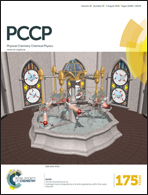Distribution and self-assisted diffusion of Be and Mg impurities in ZnO†
Abstract
The band gap width of the Be-doped ZnO correlates strongly with the distribution of the dopants. By performing first-principles calculations, it is found that an interstitial Be (Bei) atom preferably migrates in a basal plane. During the migration, such a Bei atom favorably bonds to a substituted Be (BeZn) atom, forming a new defect complex (2Be)Zn, showing a trend of aggregation of Be atoms in ZnO. Furthermore, the stability of the defect complex (2Be)Zn can be weakened by a substituted Mg (MgZn). So, the Mg impurities in Be-doped ZnO might suppress the aggregation of Be, so as to significantly improve the effect of the doped Be on modulating the band gap of ZnO.


 Please wait while we load your content...
Please wait while we load your content...